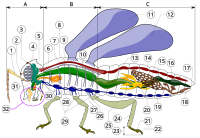
Photo from wikipedia
Genetically modified Bacillus thuringiensis is widely used for insect resistance. With the large⁃scale commercial application of transgenic insect⁃resistant plants, the risk of environmental release is a concern. The development of… Click to show full abstract
Genetically modified Bacillus thuringiensis is widely used for insect resistance. With the large⁃scale commercial application of transgenic insect⁃resistant plants, the risk of environmental release is a concern. The development of transgenic poplars could effectively control poplar pests, and the fast growth of the species makes it suitable for road greening applications. Hence, it is necessary to research and breed transgenic insect⁃resistant species with socioeconomic benefits. Transgenic Populus × euramericana ‘Neva’ carrying bivalent insect⁃resistant genes ( transgenic insect⁃resistant 107 poplar) are mainly used via the agrobacterium⁃mediated transformation method for gene transformation research in Populus × euramericana ‘Neva’ using bi⁃insect⁃resistant genes built in a vector (BtCry1Ac gene+API arrowhead protease inhibitor gene) . For transgenic plants, molecular detection and insect feeding trials have been carried out, resulting in the development of transgenic insect⁃resistant 107 poplar strains. The transgenic insect⁃resistant 107 poplar has perennial characteristics; it may directly or indirectly affect the ecological system where planted in the field on the large⁃scale. To study the effect of transgenic insect⁃resistant 107 poplar on arthropod community characteristics and relative stability, the htt p:/ /w ww .ec olo gic a.c n http: / / www.ecologica.cn arthropod communities in forests were monitored and analyzed. The research aimed to provide data support for the ecological security evaluation of transgenic poplar, and provide a reference for the popularization and application of transgenic 107 poplar. We investigated the arthropod community in transgenic insect⁃resistant 107 poplars in a nursery field in Luannan County, Tangshan City in 2015, using the community characteristic index, community similarity, community relative stability, and principal component analysis. In total, 6,818 insects, belonging to 2 classes, 8 orders, 43 families, and 58 species, were collected. The results showed that Lepidoptera, Coleoptera, Hymenoptera, and Diptera were the dominant species of transgenic insect⁃resistant 107 poplars, and Lepidoptera were the most abundant. The numbers of Lepidopteran and hemipteran individuals were significantly different between transgenic insect⁃resistant 107 poplars and the control. Compared with numbers in the control, the number of individuals of herbivorous insects in transgenic insect⁃resistant 107 poplars were significantly lower, and the number of the individuals of sucking insects were significantly higher. Compared with the control for the community characteristic indexes, the arthropod community diversity index and evenness index of transgenic insect⁃resistant 107 poplars were higher, whereas the community dominance index was lower. These results show that the species distribution of the arthropod community was more uniform in transgenic insect resistant 107 poplars than in the control. The analysis of community similarity shows that the similarity of species composition between the transgenic insect⁃resistant 107 poplar was higher than that of the control. Analysis of the relative stability of the community showed that the number of arthropod communities in transgenic insect⁃resistant 107 poplars was stronger than that of the control. The number of species and individuals of different functional groups of arthropod communities were more affected by the transgenic insect⁃resistant 107 poplar than by the control.The main factors affecting the change of arthropod communities in transgenic insect⁃resistant 107 poplars and the control were the herbivorous insect species and individual numbers, the number of sucking insects, and other species of phytophagous insects.
Journal Title: Acta Ecologica Sinica
Year Published: 2018
Link to full text (if available)
Share on Social Media: Sign Up to like & get
recommendations!